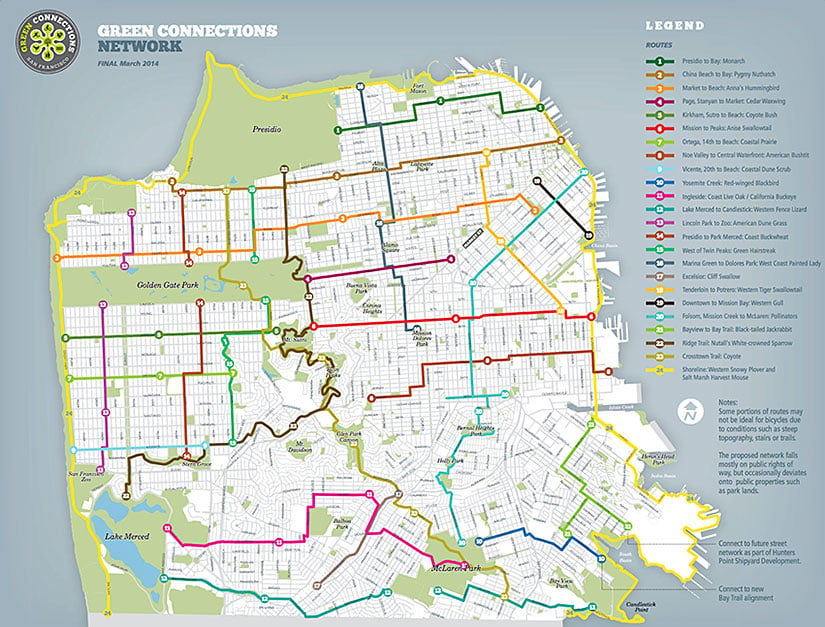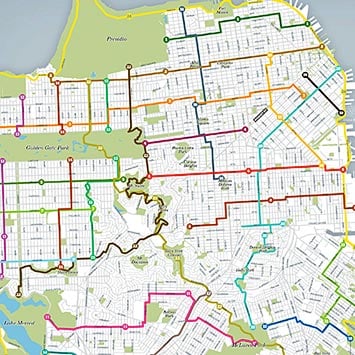A Wild Plan for San Francisco | San Francisco
In San Francisco they’re imagining a world in which cars share the road with birds, bees, butterflies, and bicyclists. We cycled a few of the wildlife corridors designated in the city’s Green Connections Plan.
Lizards, coyotes, birds, and bees: These are just a few of the wildlife species featured in the Green Connections Plan, an ambitious 115-mile, 24-route map of potential habitat corridors in San Francisco.
Each route in the network is named after a native San Francisco “Key Species” and is designed to incorporate “Key Habitat” for that species.
Developed in 2011 by the non-profit organization Nature in the City in collaboration with city and community-based agencies, the plan is designed to be phased in incrementally over the next 20 years.
“If you build it, they will come,” Green Connections director Amber Hasselbring said.
Biking along the network with Hasselbring reveals newly landscaped street medians and sidewalk gardens that have been planted to enhance San Francisco’s urban ecology.
Green Connections Routes 22 and 23 are dedicated to white-crowned sparrows and coyotes, where more shrub and grass habitats could be planted along the streets to meet the needs of these species.
There is Route 12 for the western fence lizard, which could incorporate curbside fences along with stacked stones and boulders to accommodate the lizards’ need for sunlight and perching spots.
Route 3 is named for Anna’s Hummingbirds, where bottlebrush and strawberry trees could be planted to provide a steady source of nectar in the dense downtown area.

Located to the west of San Francisco’s Twin Peaks, Route 15 is named for the green hairstreak butterfly, a locally-endangered butterfly.
Prior to urbanization and habitat loss, the green hairstreaks could be found across California. With the hairstreaks in decline and their San Francisco habitat largely confined to Hawk Hill Park and Rocky Outcrop Park in the Golden Gate Heights neighborhood, lepidopterist Liam O’Brien launched an initiative to connect these two isolated populations in 2006.
As part of the initiative, Nature in the City has planted the hairstreaks’ main larval food source, coast buckwheat, between the two parks. The female hairstreaks lay their eggs on the buckwheat, and when the caterpillars hatch, they eat the leaves. As adults, the butterflies return to feast on the plant’s nectar.
Since green hairstreaks fly only 200 to 300 feet from their homes, planting habitat between the parks joins the separated habitats. Once connected, the isolated butterfly populations can breed among each other, thereby increasing the hairstreaks’ genetic diversity.
The Green Connections routes are also designed to give people safer and easier access to parks and open spaces. The plan’s creators understand that people can struggle to access nature in the densely urbanized neighborhoods of San Francisco.
“Providing connections to places where people want to go to and access by foot or bicycle rather than always having to get there by bus or car is a goal of the plan—just to make it an easier locomotion through the city,” Hasselbring said.
Green Connections also provides ecology guides, along with an online plant-finder tool that offers residents plant recommendations for their own backyards and streetscapes.
Located just west of the Green Connections Route 20 pollinator corridor, BASE Landscapes co-founder Patricia Algara partnered with Whole Foods Market and others to transform a drought-damaged two-block grassy median along Dolores Street into the Dolores Pollinator Boulevard.
The area is now thriving with colorful flowering plants that bloom throughout the year to attract all different types of pollinators. Amber Hasselbring hopes that the boulevard will inspire similar initiatives across the urban landscape.
“Each tiny patch like this, especially if they’re done with this kind of intention in mind, can create a lot more dynamic life systems going on in the city,” Hasselbring said. “One person decided this was a vision she had and she got everyone in the neighborhood involved. She got some funding to get it done, so it’s going to have an implementation in so many ways. But if we provide a little bit of guidance about where to get the plants, how to care for these spaces and how to organize a neighborhood around a project like this, maybe city departments will start the implementation project also.”

— Sean Keenehan






